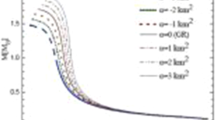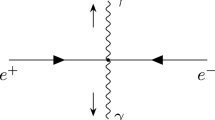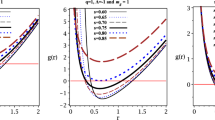Abstract
We use a modified Einstein-Maxwell gravity to study stability of an electrostatic spherical star. Correction terms in this model are scalars which are made from contraction of Ricci tensor and electromagnetic vector potential. Our motivation to use this kind of exotic Einstein-Maxwell gravity is inevitable influence of cosmic magnetic field in inflation of the universe which is observed now but its intensity suppresses in the usual gauge invariant Einstein-Maxwell gravity. In this work, we use approach of dynamical systems to obtain stability conditions of such a star and we investigate interaction parts effect of the model on the stability.



Similar content being viewed by others
References
Catton, C., Faber, T., Visser, M.: Gravastars must have anisotropic pressures. Class. Quant. Grav. 22, 4189 (2005)
Hobson, M.P., Erstathiou, G.P., Lasenby, A.N.: General Relativity An Introduction for Physicists. Cambridge University Press, Cambridge (2006)
Kumar, J., Bharti, P.: ‘An isotropic compact stellar model in curvature coordinate system consistent with observational data‘, arXiv:2102.12754 [astro-ph.GA]
Arbañil, J.D.V., Malheiro, M.: Equilibrium and stability of charged strange quark stars. Phys. Rev. D 92, 084009 (2015). arXiv:1509.07692 [astro-ph.SR]
Fontanella, D.S., Cabo, A.: ‘A stability analysis of the static EKG Boson Stars’, arXiv:2101.04681 [gr-qc]
Arbail, J.D.V., Malheiro, M.: Equilibrium and stability of charged strange quark stars. Phys. Rev. D 92, 084009 (2015). arXiv:1509.07692 [astro-ph.SR]
Jimnez, J.C., Fraga, E.S.: Radial oscillations in neutron stars from QCD. Phys. Rev. D 104, 014002 (2021). arXiv:2104.13480 [hep-ph]
Kain, B.: Fermion-charged-boson stars. Phys. Rev. D 104, 043001 (2021). arXiv:2108.01404 [gr-qc]
Wang, W., Feng, Y., Lai, X., Li, Y., Lu, J., Chen, X., Xu, R.: The optical/UV excess of X-ray-dim isolated neutron star II. Nonuniformity of plasma on strangeon star surface. Res. Astron. Astrophys. 18, 082 (2018). arXiv:1705.03763 [astro-ph.HE]
Wang, W., Lu, J., Tong, H., Ge, M., Li, Z., Men, Y., Xu, R.: The optical/UV excess of X-ray dim isolated neutron star: I. Bremsstrahlung emission from a strangeon star plasma atmosphere. Astrophys. J. 837, 81 (2017). arXiv:1603.08288 [astro-ph.HE]
Turner, M.S., Widrow, L.M.: Inflation Produced, Large Scale Magnetic Fields. Phys. Rev. D 37, 2743 (1988)
Ghaffarnejad, H.: Canonical quantization of modified non-gauge invariant Einstein-Maxwell gravity and stability of spherically symmetric electrostatic stars. Phys. Scr. 98, 075018 (2023). arXiv:2306.10285 [gr-qc]
Ghaffarnejad, H., Naderi, L.: ‘Modified Gauge Invariance Einstein Maxwell Gravity and Stability of Spherical Stars with Magnetic Monopoles’, arXiv:2212.09485 [gr-qc]
Ghaffarnejad, H., Yaraie, E.: ‘Dynamical system approach to scalar-vector-tensor cosmology‘, Gen. Relativ Gravit 49, 49; arXiv:1604.06269 [physics.gen-ph] (2017)
Ghaffarnejad, H., Gholipour, H.: Bianchi I metric solutions with nonminimally coupled Einstein-Maxwell gravity theory. Gen. Relativ. Gravit 53, 1 (2021). arXiv:2003.14216 [gr-qc]
Funding
The authors did not receive support from any organization for the submitted work.
Author information
Authors and Affiliations
Corresponding author
Ethics declarations
Conflict of interest
The authors have no competing interests to declare that are relevant to the content of this article.
Additional information
Publisher's Note
Springer Nature remains neutral with regard to jurisdictional claims in published maps and institutional affiliations.
Appendices
Appendix I
By looking at the Eqs. (2.4) and (2.8) we define
in which
with
By using the Bianchi‘s identity \(\nabla ^{\mu }G_{\mu \nu }=0,\) the Eq. (8.1) gives the following identity for general form of matter stress tensor \(T_{\mu \nu }\) which we considered in this work such that
because \(\nabla ^\mu T_{\mu \nu }^{em}=0.\) In other words, unknown matter stress tensor \(T_{\mu \nu }\) which we considered here should interact with other fields called as gravity and Maxwell fields to support covariant conservation condition for the total stress tensor \(T_{\mu \nu }^{total}\) which we assumed behaves as an anisotropic imperfect fluid with the stress tensor form (2.8).
Appendix II
and
Rights and permissions
Springer Nature or its licensor (e.g. a society or other partner) holds exclusive rights to this article under a publishing agreement with the author(s) or other rightsholder(s); author self-archiving of the accepted manuscript version of this article is solely governed by the terms of such publishing agreement and applicable law.
About this article
Cite this article
Ghaffarnejad, H., Ghorbani, T. & Eidizadeh, F. On the stability of electrostatics stars with modified non-gauge invariant Einstein-Maxwell gravity. Gen Relativ Gravit 55, 135 (2023). https://doi.org/10.1007/s10714-023-03183-8
Received:
Accepted:
Published:
DOI: https://doi.org/10.1007/s10714-023-03183-8




